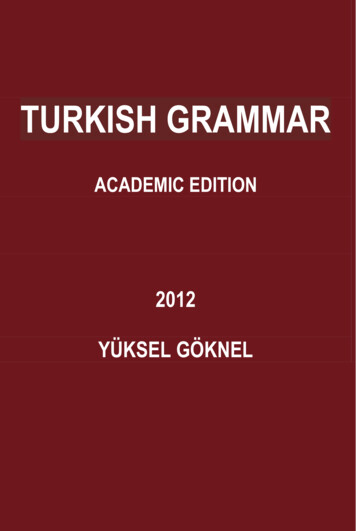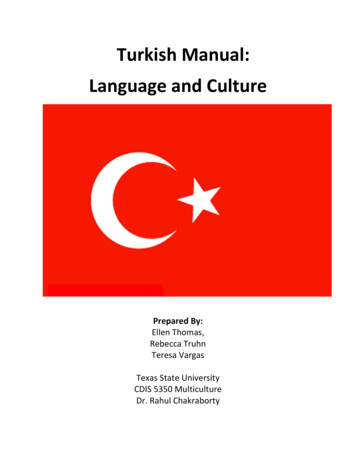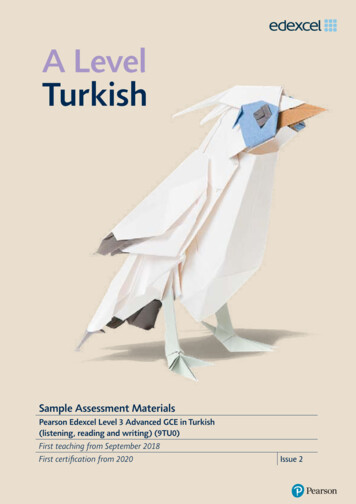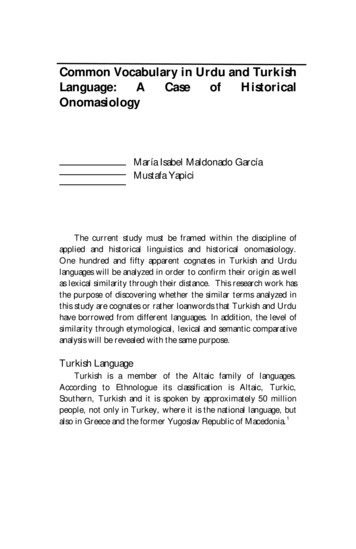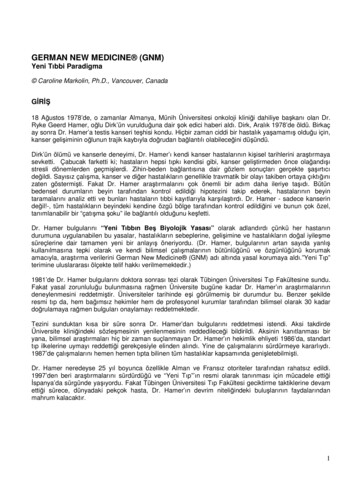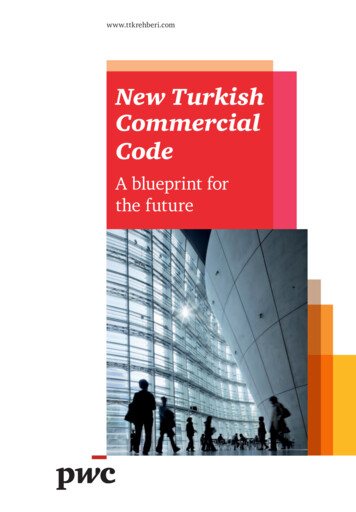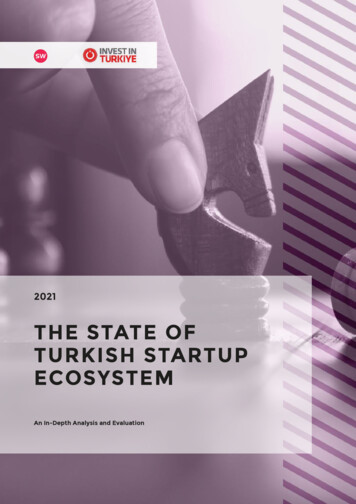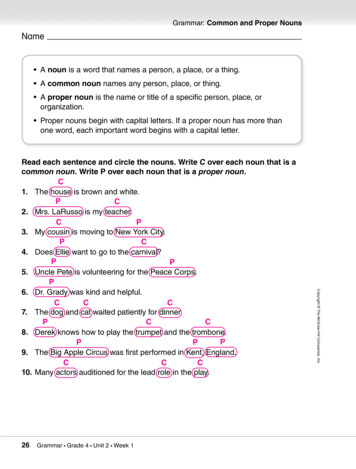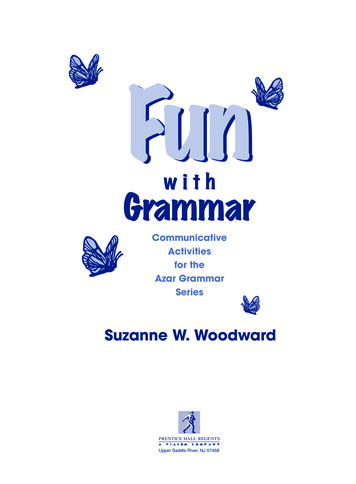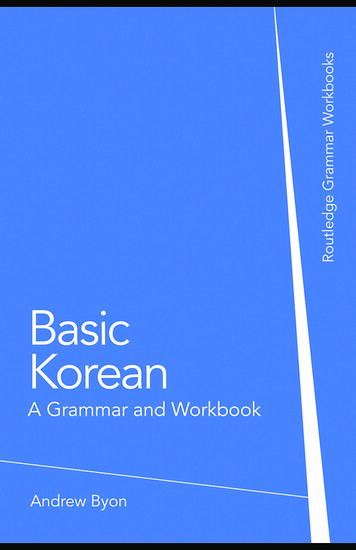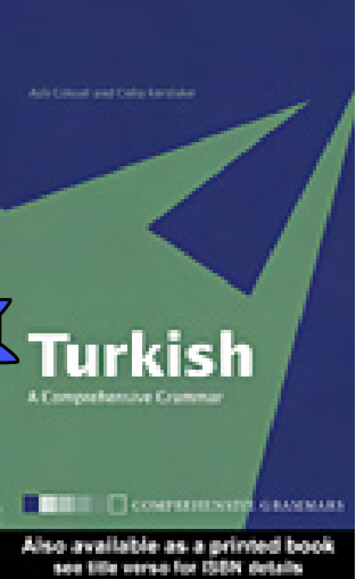
Transcription
TURKISH: A COMPREHENSIVEGRAMMARRoutledge Comprehensive GrammarsComprehensive Grammars are available for the following languages:Modern Written esianJapaneseSloveneSwedishTurkishUkrainianModern WelshTitles of related interest
Colloquial Turkish: A Complete Course for BeginnersJeroen Aarssen and Ad BackusDictionary of the Turkic LanguagesKurtuluş Öztopçu, Zhoumagaly Abuov, Nasir Kambarov and Youssef Azemoun
TURKISH: A COMPREHENSIVEGRAMMARAslı Göksel and Celia KerslakeLONDON AND NEW YORK
First published 2005 by Routledge 2 Park Square, Milton Park, Abingdon, Oxon OX14 4RNSimultaneously published in the USA and Canada by Routledge 270 Madison Ave, New York,NY 10016Routledge is an imprint of the Taylor & Francis GroupThis edition published in the Taylor & Francis e-Library, 2006.“To purchase your own copy of this or any of Taylor & Francis or Routledge’s collection ofthousands of eBooks please go to http://www.ebookstore.tandf.co.uk/.” 2005 Aslı Göksel and Celia KerslakeAll rights reserved. No part of this book may be reprinted or reproduced or utilized in any form orby any electronic, mechanical, or other means, now known or hereafter invented, includingphotocopying and recording, or in any information storage or retrieval system, without permissionin writing from the publishers.British Library Cataloguing in Publication Data A catalogue record for this book is available fromthe British LibraryLibrary of Congress Cataloging in Publication Data has been applied forISBN 0-203-34076-0 Master e-book ISBNISBN 0-415-11494-2 (pbk)ISBN 0-415-21761-X (hbk)
ationsxviiList of conventions observed in this bookThe Turkish alphabet and writing conventionsPart 1 Phonology: the sound system1 Phonological unitsxxxxii132 Sound changes produced in the stem by suffixation143 Vowel harmony214 Word stress265 Intonation and sentence stress35Part 2 Morphology: the structure of words416 Principles of suffixation437 Word classes, derivation and derivational suffixes498 Inflectional suffixes659 Reduplication9010 Noun compounds11 Clitics94100
Part 3 Syntax: the structure of sentences10712 Simple and complex sentences10913 The verb phrase12614 The noun phrase14415 Adjectival constructions, determiners and numerals17016 Adverbial constructions18917 Postpositional phrases21418 Pronouns23019 Questions25120 Negation27121 Tense, aspect and modality28322 Definiteness, specificity and generic reference32223 Word order33724 Noun clauses35125 Relative clauses38026 Adverbial clauses39927 Conditional sentences41928 Conjunctions, co-ordination and discourse connection438Appendix 1 Reduplicated stems462Appendix 2 Tense/aspect/modality suffixes465Glossary of grammatical terms470Bibliography480Index484
ACKNOWLEDGEMENTSThe present book would not have been in the form it is had it not been for the generousfeedback of the following colleagues, friends and students, linguists and teachers andusers of Turkish, who read and commented on parts of the manuscript: Didar Akar,Öznur Ayman, Ercan Balcı, Cem Çakır, Georgia Catsimali, Monik Charette, RuthChristie, Ann Denwood, Dilek Elçin, Eser Erguvanlı-Taylan, Kate Fleet, JorgeHankamer, Katerina Hardiman, Atakan İnce, Meltem Kelepir, Elisabeth Kendall,Wilfried Meyer-Viol, Mine Nakipoğlu-Demiralp and A.Sumru Özsoy. We are grateful toall these people for sparing the time to help us in this way.We owe special thanks to Ceyda Arslan for reading the whole manuscriptmeticulously. Her detailed and insightful corrections helped us avoid many errors.Dimitris Antoniou and Andras Riedlmayer provided valuable help in pointing us tosome of the statistics about Turkish speakers outside Turkey, and Mehmet Ölmez,Şükriye Ruhi and Güneş Müftüoğlu kindly responded to our questions about referencegrammars in current use for teaching purposes in Turkey. We are indebted to MeltemKelepir, Zeynep Kulelioğlu, Mine Nakipoğlu-Demiralp, Gülen Ergin and Müfide Pekinfor their readiness to give us their acceptability judgements on problematic constructions,and to Onat Işık for his technical help in transferring several files from one computersystem to another. We are also grateful to our students at Boğaziçi and OxfordUniversities, who (whether they were aware of it or not) constantly brought to ourattention aspects of Turkish that we might not otherwise have thought about.Gratitude is due to our successive editors at Routledge, Simon Bell, Sophie Oliver,Sarah Butler, Liz O’Donnell and Ruth Jeavons for their feedback and patience throughoutthe years, and to several anonymous reviewers for their comments.During the preparation of this book we have drawn heavily on the work of others,some of it unpublished. Unfortunately the format of this book does not allow us toacknowledge our sources at the appropriate points in the text. We hope that this will notgive the impression that all the observations and descriptions presented in the bookbelong originally to us, and that we will be forgiven for having to content ourselves withsimply including our sources in the bibliography. Needless to say, responsibility for anyshortcomings that this book may have rests entirely with ourselves.Finally, we should like to thank our closest friends and our families for their unfailingsupport in what has been a prolonged and often too absorbing task.Aslı GökselCelia KerslakeJuly 2004
INTRODUCTIONTURKISH AND ITS SPEAKERSTurkish belongs to the Turkic family of languages, which have been spoken for manycenturies across a vast territory from the Balkans to China. Within this family, whichincludes such languages as Uighur, Uzbek, Tatar and Kazakh, Turkish forms part of thesouthwestern or Oghuz branch. Its closest relatives are Gagauz (spoken by less than200,000 people of Orthodox Christian religion, mostly in southern Moldova),Azerbaijanian (spoken by up to 20 million people in Iran and Azerbaijan) and Turkmen(spoken by some 3 million people in Turkmenistan and by about 400,000 in Iraq).Turkish itself is spoken predominantly in the Republic of Turkey, of which it is theofficial language. No statistics are available as to how many of Turkey’s population of 70million have Turkish as their first language. Most of the ethnic minorities have undergoneconsiderable (in some cases, total) linguistic assimilation. In the largest ethnic minority,that of the Kurds (which is variously estimated to make up between 8 per cent and 20 percent of the country’s population), a large number of people are bilingual. A reasonableestimate would probably be that Turkish is now the first language of 55–60 million ofTurkey’s citizens, with another few million people speaking it with equal fluency to theirnative language.Turkish speakers outside Turkey fall into two groups. The first consists ofcommunities located in various lands that were formerly, for several centuries, part of theOttoman Empire. There are populations of this kind in Bulgaria (760,000), Greece(115,000), Macedonia (80,000) and Romania (23,000). Cyprus, also former Ottomanterritory, has seen its Turkish-speaking population considerably enlarged by migrationfrom Turkey since 1974. There may be as many as 150,000–200,000 Turkish speakersliving in the Turkish Republic of Northern Cyprus at the time of writing.The second group of Turkish speakers outside Turkey comprises those who, since the1960s, have taken up residence in various western European countries, Australia andNorth America. The number in western Europe is nearly 4 million, of whom half live inGermany. The Australian Turkish community numbers some 40,000, and the number ofTurkish speakers in North America is 50,000–60,000. Although in all these migrantcommunities there is a tendency for the use of Turkish to decline with each succeedinggeneration, it can probably be stated with reasonable certainty that Turkish is spoken as afirst language or with native fluency by about 65 million people worldwide.
BREAK WITH THE OTTOMAN PASTThe Turkish language underwent two kinds of radical change as part of the revolutionaryreform programme launched by Mustafa Kemal (Atatürk) after the establishment of theRepublic in 1923. The first was a sudden and comprehensive change in the medium inwhich it was written, with the introduction of a specially adapted form of the Latinalphabet in 1928, accompanied by a total prohibition on any further use of the Arabicscript for teaching or publication in Turkish. The second affected the substance of thelanguage itself, particularly its lexicon, and comprised a systematic campaign, launchedby the official Turkish Language Foundation in 1932, to ‘liberate’ Turkish from its‘subjugation’ to other languages, i.e. to Arabic and Persian. In order to give someindication of the significance of this change it will be necessary to say something aboutthe Ottoman form of Turkish, the precursor of the modern language.As a linguistic term, ‘Ottoman’ denotes the form of Turkic which became the officialand literary language of the Ottoman Empire (1300–1922). This was, essentially, thevariety of Oghuz Turkic which developed in Anatolia after that region was settled byOghuz Turks in the eleventh to thirteenth centuries. It was written in the Arabic script,the form of writing adopted not only by the Oghuz but by all the Turkic-speaking peopleswho, from about the tenth century onwards, had accepted the Islamic faith. The primacyaccorded in Islam to the Arabic language itself, the language of the Qur’an, had aprofound impact on the intellectual life of Ottoman society. The language of scholarshipand of Islamic law, and the medium of instruction in the only schools available to theMuslim population before the nineteenth century, the medreses, was Arabic. In literature,on the other hand, the influence that was more directly felt was that of Persian, since itwas the aesthetics of Persian poetry and ornate prose that provided inspiration for theOttoman literati. A truly cultured Ottoman was expected to have a fluent command of‘the three languages’, and many Turkish-speaking Ottomans did indeed write treatises inArabic and/or poetry in Persian.As far as Ottoman itself was concerned, the degree to which written texts reflected thespoken idiom varied greatly according to the level of education of the writer and thepurpose and intended readership of the document. In any kind of sophisticated writing theTurkish structural base became all but submerged, surfacing mainly in the inflectionalmorphology and in other non-lexical items such as pronouns, determiners, and auxiliaryverbs. Arabic and Persian borrowings were not confined to the lexicon, but includedgrammatical elements also. Arabic words were often used in their distinctive pluralforms, and adjectives were made to agree with them in terms of gender, as they would inArabic itself. A host of Arabic prepositional phrases, completely alien to Turkish syntax,were imported more or less as lexical units. A number of Persian constructions becameparticularly prevalent. One was the ubiquitous izafet, by which the head of a noun phrasewas linked to the modifying noun or adjective that followed it (as in asakir-i Islam‘armies of Islam’ or memalik-i Osmaniye ‘Ottoman dominions’). Another was thecompound adjective, used mainly for ornamental or rhetorical reasons, and oftendesigned to rhyme with its head noun (as in padişah-ı alem-penah, ‘world-shelteringmonarch’ or vezir-i Asaf-tedbir ‘vizier wise as Asaf’). It should be noted that the majorityof these imported elements were totally absent from the language of the unschooled
Turkish-speaking masses. On the other hand, some common words of Arabic or Persianorigin, such as perde ‘curtain’, kitap ‘book’, namaz ‘ritual prayer’, cami ‘mosque’, hadbecome fully integrated into the general lexicon. The only significant foreigngrammatical influence to be seen in the popular language was the Indo-European type ofsubordinate clause (introduced by a subordinating conjunction, and having a finite verb.(See the clauses with ki discussed in Chapters 24–6 of this book.)The term ‘Ottoman’ was not applied to the language of the Ottoman state until themid-nineteenth century, when, as part of the reform movement known as the Tanzimat,attempts were made by the government to foster a sense of Ottoman identity that mightsave the ailing empire. Before then, when it was necessary to distinguish Turkish fromany other language, it had been called precisely that (Türki or Türkçe), howeverimpregnated it might have been with Arabic and Persian elements. It was in the Tanzimatperiod that Turkish (under the politicized name ‘Ottoman’) first began to be taught inschools, the new state schools designed to train soldiers, bureaucrats and technicalexperts for the service of a modernized state. There was now a clear need for thelanguage to be defined and streamlined, through the production of grammars anddictionaries, in order to maximize its effectiveness as a means of public communication.A newly emerging class of Turkish intellectuals, who had access to Western writings andwere full of new ideas that they wanted to convey to a wide public, shared the state’sinterest in regularizing and simplifying the language, although their standpoint—liberaland patriotic—was largely opposed to the government. The new genres of writing inwhich they were involved, principally journalism, drama and the novel, all played theirpart in the evolution of a modern form of Ottoman, shorn of much of its rhetoricalopacity, and with a regularized, transparent sentence structure much closer to that ofmodern Turkish.The closing decades of the life of the Ottoman Empire witnessed the emergence of anew sense of ethnic identity among the Turkish educated elite, which had hitherto defineditself only as Ottoman and Muslim. The discoveries of European Turcologists drewattention to the long-forgotten linguistic and cultural links existi
Turkish structural base became all but submerged, surfacing mainly in the inflectional morphology and in other non-lexical items such as pronouns, determiners, and auxiliary verbs. Arabic and Persian borrowings were not confined to the lexicon, but included grammatical elements also. Arabic words were often used in their distinctive plural forms, and adjectives were made to agree with them in .
